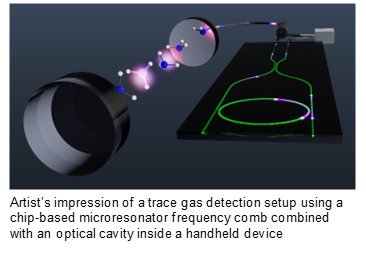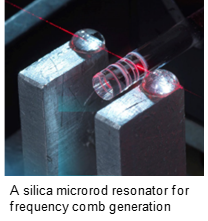The Quantum Sensors and Timing Hub is led by the University of Birmingham and coordinates the UK academia and industry expertise to support innovation in sensors and timing.
Frequency combs consist of thousands of optical frequencies all equally spaced and spanning the optical and microwave range. If the two degrees of freedom of a comb are stabilised by reference to an atomic transition, the stability of the atomic reference is transferred to all other frequencies output from the comb.
Future compact atomic clocks have the potential to provide precise timing to a variety of critical infrastructure services, such as energy supply, transport links, mobile communications, data networks and electronic financial transactions. This technology has wide ranging application beyond timing. For example, in the telecoms industry a single chip-based microresonator frequency comb could replace the hundreds of lasers currently needed to send data down each optical fibre, and the security industry could use frequency combs as handheld, ultrafast trace gas sensor for detecting explosives.
However, despite being a hugely powerful tool for metrology and other sensing applications, conventional combs are bulky and expensive, making them unsuitable for mass-market applications. The NPL project on microcombs aims to create a small frequency comb based on a miniature optical microresonator.
Find out more about NPL’s research on Microphotonics
Find out more about the Quantum Sensors and Timing Hub
Find out more about the NQTP Hubs


Optical microresonators can perform the same job as combs on a single chip with far less power. NPL is developing frequency combs based on microresonators, with greatly reduced size, weight, power and cost compared to systems currently on the market.
The project involves work with both the Universities of Glasgow and Southampton, bringing their advanced fabrication capability to this project.